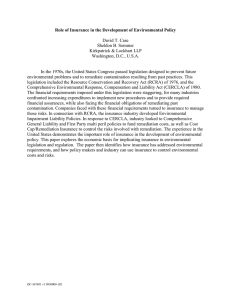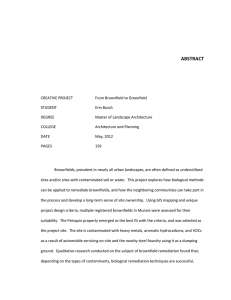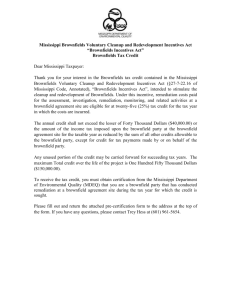DRAFT – FOR CONSIDERATION AT THE APRIL 27, 2006
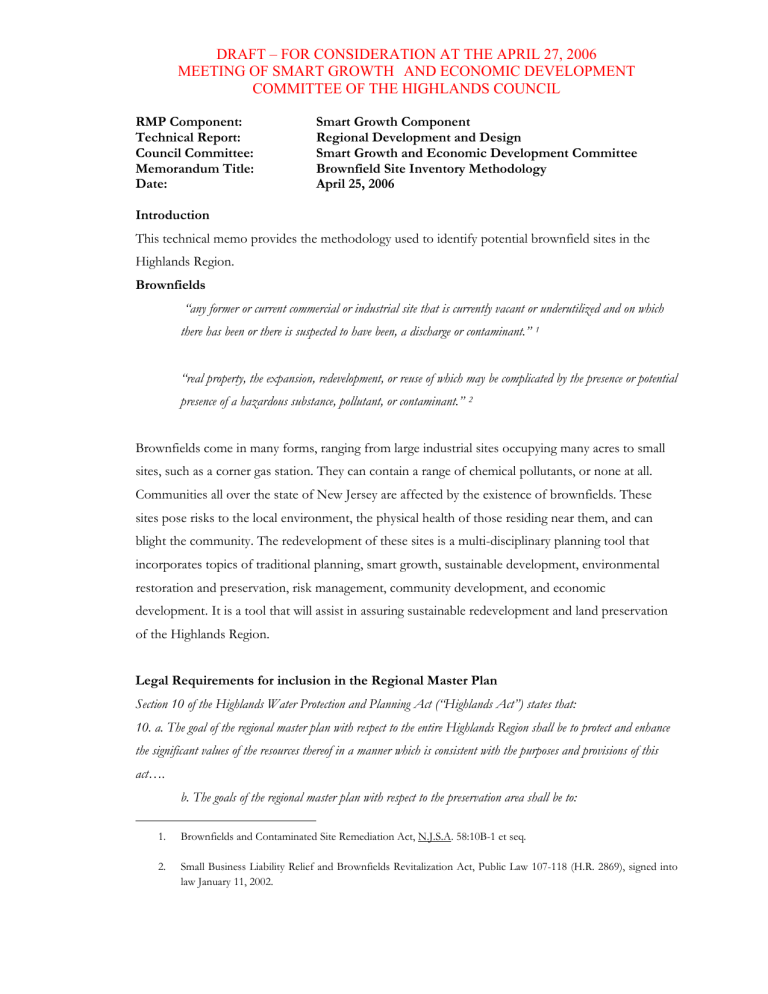
DRAFT – FOR CONSIDERATION AT THE APRIL 27, 2006
MEETING OF SMART GROWTH AND ECONOMIC DEVELOPMENT
COMMITTEE OF THE HIGHLANDS COUNCIL
RMP Component:
Technical Report:
Council Committee:
Memorandum Title:
Date:
Introduction
Smart Growth Component
Regional Development and Design
Smart Growth and Economic Development Committee
Brownfield Site Inventory Methodology
This technical memo provides the methodology used to identify potential brownfield sites in the
Highlands Region.
Brownfields
“any former or current commercial or industrial site that is currently vacant or underutilized and on which there has been or there is suspected to have been, a discharge or contaminant.”
“real property, the expansion, redevelopment, or reuse of which may be complicated by the presence or potential presence of a hazardous substance, pollutant, or contaminant.”
Brownfields come in many forms, ranging from large industrial sites occupying many acres to small sites, such as a corner gas station. They can contain a range of chemical pollutants, or none at all.
Communities all over the state of New Jersey are affected by the existence of brownfields. These sites pose risks to the local environment, the physical health of those residing near them, and can blight the community. The redevelopment of these sites is a multi-disciplinary planning tool that incorporates topics of traditional planning, smart growth, sustainable development, environmental restoration and preservation, risk management, community development, and economic development. It is a tool that will assist in assuring sustainable redevelopment and land preservation of the Highlands Region.
Legal Requirements for inclusion in the Regional Master Plan
Section 10 of the Highlands Water Protection and Planning Act (“Highlands Act”) states that:
10. a. The goal of the regional master plan with respect to the entire Highlands Region shall be to protect and enhance the significant values of the resources thereof in a manner which is consistent with the purposes and provisions of this act…. b. The goals of the regional master plan with respect to the preservation area shall be to:
1.
Brownfields and Contaminated Site Remediation Act, N.J.S.A. 58:10B-1 et seq.
2.
Small Business Liability Relief and Brownfields Revitalization Act, Public Law 107-118 (H.R. 2869), signed into law January 11, 2002.
4/26/2006
(1) protect, restore, and enhance the quality and quantity of surface and ground waters therein;
…(7) promote brownfield remediation and redevelopment; c. The goals of the regional master plan with respect to the planning area shall be to:
(1) protect, restore, and enhance the quality and quantity of surface and ground waters therein;
…(8) promote brownfield remediation and redevelopment;
11.a. The regional master plan shall include, but not necessarily be limited to:
(6) A smart growth component that includes an assessment…of opportunities for appropriate development, redevelopment, and economic growth, and a transfer of development rights program which shall include consideration of public investment priorities, infrastructure investments, economic development, revitalization, housing, transportation, energy resources, waste management, recycling, brownfields, and design such as mixed-use, compact design, and transit villages.
Brownfield Site Inventory Methodology
This section describes the sources and methodology used to quantify brownfield sites in the
Highlands Region. The goal of this analysis was to gain a regional perspective on the numbers and locations of brownfield sites. The analysis consisted of a compilation of data sources regarding contaminated sites and GIS (Geographical Information System) mapping.
The New Jersey Department of Environmental Protection’s (“NJDEP”) Known Contaminated Sites in New Jersey (“KCS-NJ”) report contains information for over 13,000 contaminated sites located throughout the State. Sites become listed if contamination of soil or ground water has been confirmed. KCS-NJ was used as a starting point for identifying brownfield sites in the Highlands
Region. Guidelines was developed in order to identify sites with potential for restoration and redevelopment. Once the list of potential sites was established, the parcel size, the remedial level, and the zoning were considered. Appendix A contains definitions pertaining to the KCS-NJ Remedial
Level.
In order to gain the most appropriate and useful information from the KCS-NJ list, the list was pared down based on the following steps:
1.
Sites with a Remedial Level of A or B were removed because they generally involve cases where contaminants do not have an impact to soil or groundwater;
4/26/2006
2.
Sites with a Remedial Level of C1 were removed because they are generally considered to be simple sites with one or two contaminants that are localized to soil and the immediate spill or discharge area. The only instance where a site with a Remedial Level of C1 was kept was if the Contact Bureau was Site Assessment, Bureau of Case Management, or Bureau of
Design and Construction. In some circumstances, those bureaus are involved with
Superfund projects, which are of relevance to this inventory;
3.
Sites with a Remedial Level of C2 were removed only if the Contact Bureau was Bureau of
Field Operations - Northern or Bureau of Field Operations – Southern and the Place Name was a street address, which generally signifies a residential address. The Bureau of Field
Operations Northern/ Southern work with homeowners, and the removal of underground heating storage tanks.; and
4.
If the Contact Bureau was the County Environmental Health Agency, it was removed. The
County Environmental Health Agency generally oversees remedial activities that involve residential home heating oil tanks that have not impacted ground water.
The next available database examined was the Comprehensive Environmental Response,
Compensation and Liability Information System (“CERCLIS”). A Superfund site is any area that has been identified by the United States Environmental Protection Agency (“USEPA”) to be contaminated by hazardous waste and is a candidate for cleanup because it poses a risk to human health and the environment. The CERCLIS database contains information for sites that are included on the National Priorities List (“NPL”). The list includes proposed, final, and deleted NPL sites.
The next database examined was based upon Resource Conservation and Recovery Act (“RCRA”) information. RCRA was enacted in 1976, and later amended in 1984 by the Hazardous and Solid
Waste Amendments. It was designed to address the management and disposal of municipal and industrial waste. The goals of RCRA are to “protect human health and the environment from potential hazards of waste disposal, to conserve energy and natural resources, to reduce the amount of waste generated, and to ensure that wastes are managed in an environmentally sound manner”.
RCRA consists of three components; the management of non-hazardous solid waste, hazardous waste, and underground storage tanks.
3.
“What is RCRA”, United States Environmental Protection Agency, March 23, 2006,
<http://www.epa.gov/region02/waste/what.htm>
4/26/2006
All hazardous waste handlers, including generators, transporters, treaters, storers and disposers of hazardous waste are required to provide certain information about their activities. In New Jersey, this information is provided to NJDEP’s Bureau of Solid & Hazardous Waste Regulation, which passes the information on to the USEPA. This data, including permit status, compliance and violation information and cleanup activities, contributes to the Resource Conservation and Recovery Act
Information (“RCRAInfo”). The RCRAInfo and the Hazardous Waste Query Form were utilized in order to determine potential hazardous waste RCRA sites in the Highlands Region.
Within the RCRAinfo database, there are several terms that require clarification:
1.
Handler generally refers to a facility, but can also include waste haulers or transporters;
2.
TSD refers to treatment, storage or disposal of hazardous waste, and also includes recycling.
TSD waste units are classified by RCRA to be within the categories of treatment, storage, land disposal (landfill), incineration, and boiler or industrial furnace; and
3.
Corrective Action is a cleanup of escaped or spilled waste that usually occurs at the operating facility.
The following parameters were set in order to search the RCRAinfo database:
1.
A geography search for each county in the Highlands Region was run with the following handler parameters. a.
“Full Enforcement Universe, which captures all TSDFs that are legally subject to
TSDF operations and management regulations under RCRA Subtitle C, and includes both currently operating TSDFs as well as closed but not certified closed
TSDFs. b.
Closure Workload Universe includes units that are closing up to the time that closure certification is verified by the agency, and also includes operating facilities or facilities under construction that are also non-notifiers. This universe does not include facilities that have completed closure and have been certified clean closed or certified closed with waste in place, and those facilities going through post-closure.
In addition, units that have been transferred to Superfund are not included.
4.
“About RCRIS Data”, Right To Know Network, March 23, 2006
<http://www.rtknet.org/new/rcris/genhelp.php>
4/26/2006 c.
Post Closure Universe includes closing land disposal units and storage units closing as landfills up to the time that clean closure certification is verified by the agency.
Units that have been transferred to Superfund are not included. d.
Treatment, Storage, Disposal Facilities (TSDFs) Potentially Subject to Corrective
Action under 3004 (U)/(V), which consists of TSDFs that could potentially be required to address corrective action through the statutory requirements under
§3004(u)/(v); it is not driven by the authority used to implement corrective action. It includes interim status facilities that are not clean closed. e.
Subject to Corrective Action captures all facilities potentially subject to corrective action regardless of whether they have corrective action underway plus any handlers showing a corrective action event for RFI or beyond. Handlers conducting corrective action under analogous state authorities are also included.”
2.
The process search parameter was set for all types of facilities, including those that operate disposal, storage, treatment and miscellaneous other processes. The processes include: a.
Disposal Processes; Underground Injection for Well Disposal, Landfill, Land
Application, Ocean Disposal, Surface Impoundment Disposal, Other Disposal; b.
Storages Process; Container, Tank Storage, Waste Pile, Surface Impoundment
Storage, Drip Pad, Containment Building – Storage, Other Storage; c.
Treatment Process; Tank Treatment, Surface Treatment, Incinerator, Other
Treatment, Boiler, Cement Kiln, Lime Kiln, Aggregate Kiln, Phosphate Kiln,
Smelting /Melting/ Refining Furnace, Coke Oven, Blast Furnace, Titanium Dioxide
Chloride Process Oxidation Reactor, Methane Reforming Furnace, Pulping Liquor
Recovery Furnace, Combustion Device Used in the Recovery of Sulfur Values from
Spent Sulfuring Acid, Other Industrial Furnaces Listed in Title 40 (Protection of
Environment) Code of Federal Regulations 260.10 (Hazardous Waste Management
System), Halogen Acid Furnace, Containment Building – Treatment; and d.
Miscellaneous Process; Open Burning/Open Detonation, Thermal Unit, Mechanical
Processing, Geologic Repository, Other Subpart X Units.
5.
“TSDF Program Universes”, United States Environmental Protection Agency(USEPA), June 2003, A document that contains explanations for the TSD universes used in RCRAinfo and was obtained from an USEPA representative.
6.
“What is RCRA”, United States Environmental Protection Agency, March 23, 2006,
<http://www.epa.gov/region02/waste/what.htm>
4/26/2006
Two tiers of brownfields were created based upon information gleaned from KCS-NJ, the CELCLIS database and RCRAinfo. Tier 1 sites are if a higher priority and Tier 2 sites are of lesser concern.
Tier 1 consists of:
1.
All Final and Deleted Superfund sites (CERCLIS);
2.
All RCRA identified sites;
3.
All projects with a Remedial Level of C3 or D (KCS-NJ); and
4.
Projects with a Remedial Level of C2 located in the Preservation Area (KCS-NJ).
Tier 2 consists of:
1.
All projects with a Remedial Level of C2 that have not been removed due their Contact
Bureau and Place Name located in the Planning Area (KCS-NJ).
Table 1: KCS-NJ, CERCLIS and RCRA Tier 1& 2 Sites
Tier 1
Greater than 5 acres
Final NPL Sites
Deleted NPL Sites
Tier 2
Preservation Area
98
41
3
0
0
Planning Area
125
68
8
3
365
Entire Highlands
Region
223
109
11
3
365
The primary data sources for the brownfield site inventory are those identified using the aforementioned methodology. Secondary sources will be used to cross-reference the brownfield inventory, and include:
NJDEP Datasets: o
2002 Land Use Land Cover – This data layer contains statewide land use and natural land cover, based on photography captured in 2002; o
Chromate Waste Sites – This data layer includes sites where chromate contamination of soil or ground water has been identified; and includes sites where remediation is either currently under way, required but not yet initiated, or has been completed; o
Deed Notice Extent - This data layer identifies those KCS-NJ or sites on Site
Remediation Programs' Comprehensive Site List that have been assigned a deed notice;
4/26/2006 o
Ground Water Contamination Areas - This data layer identifies those KCS-NJ or sites on the Site Remediation Program Comprehensive Site List where groundwater contamination has been identified and, where appropriate, the NJDEP has established a Classification Exception Area (CEAs). CEAs are institutional controls in geographically defined areas within which the New Jersey Ground Water Quality
Standards for specific contaminants have been exceeded; o
Historic Fill – This data layer identifies areas of historic fill covering more than approximately 5 acres. For the purposes of the data layer, historic fill is nonindigenous material placed on a site in order to raise the topographic elevation of the site; o
Hazardous Sites – This data layer consists of samples collected as part of a Site
Investigation, Remedial Investigation or Remedial Action; o
New Jersey Geological Survey Wellhead Protection Areas This data layer identifies area calculated around selected wells in New Jersey and delineates the horizontal extent of ground water captured by a well pumping at a specific rate over a two-, five-, and twelve-year period of time for confined wells;
Additional NJDEP information that may be considered includes solid waste facilities and junkyard locations;
Impervious Surface Coverage – This data layer calculated the percentage of impervious surface. This analysis will contribute to our understanding of which areas have been previously developed and the intensity of development;
New Jersey Site Mart data – New Jersey Brownfields Task Force data source which is intended to market brownfield sites to developers; and
USEPA Site Assessment Grants - Assessment grants are awarded to communities or regions in order to fund explorations and demonstrations of brownfield solutions.
Next Steps:
As the development of the Regional Master Plan continues, additional analyses will be completed, and will help to enrich our understanding of redevelopment potential in the region. The additional analysis will include:
Evaluation of land development impacts;
Evaluation of water/wastewater demand;
Evaluated redevelopment implications on build out;
Demographic analysis – including population and employment figures;
4/26/2006
Aesthetics and regional planning implications – consider how this development will contribute to the region, as a whole. Where is new development going to be built, how will it look, and what will the implications be for the existing population; and
Consultation with local and regional planning or development officials for input on brownfield and redevelopment inventory through Plan Conformance Process.
DRAFT – FOR CONSIDERATION AT THE APRIL 27, 2006
MEETING OF NATURAL RESOURCES COMMITTEE
OF THE HIGHLANDS COUNCIL
Appendix A: Remedial Level Definitions
Remedial
Level
A
B
C1
C2
C3
D
Description
Emergency Action - Stabilization.
A single phase remedial action with a single contaminant affecting only the soil.
Remediation does not require a formal design. The source of the contamination is known or has been identified. There is a potential for ground water contamination.
Remediation requires a formal design. The source of the contamination is known
OR the release has caused ground water contamination.
A multi-phased remediation action. Where the source of the contamination is either unknown or there is an uncontrolled discharge to Soil and/or ground water.
A multi-phased remediation with multiple sources/releases to multiple media including ground water.
7.
“Known Contaminated Sites in New Jersey” 6 th Edition; 2005 Report, Part III. KCSNJ Report Definitions, April
25, 2006, <http://www.nj.gov/dep/srp/kcs-nj/>
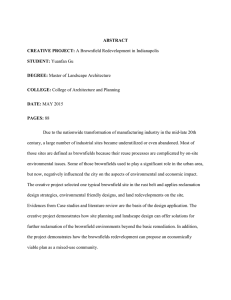
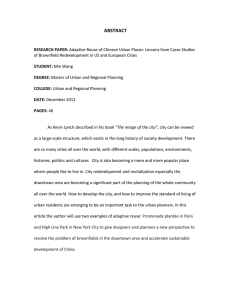
![Car Wash - Teachers [] - Carnegie Mellon University](http://s3.studylib.net/store/data/007759052_2-dc7f9f6e7ee8d5936ad1af830ebd5069-300x300.png)
